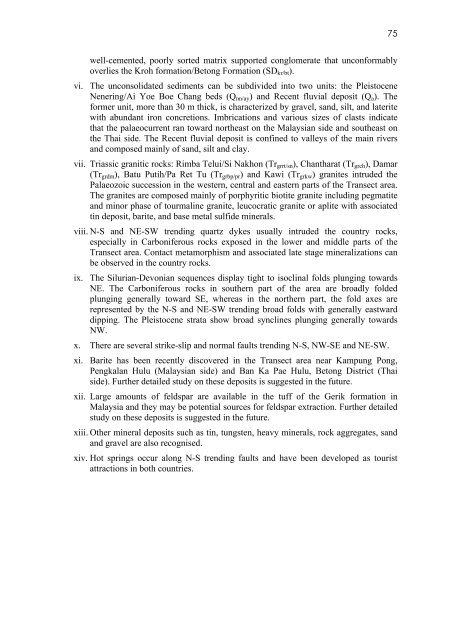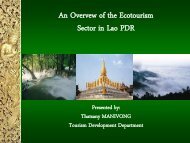GEOLOGY OF THE PENGKALAN HULU-BETONG TRANSECT ...
GEOLOGY OF THE PENGKALAN HULU-BETONG TRANSECT ...
GEOLOGY OF THE PENGKALAN HULU-BETONG TRANSECT ...
Create successful ePaper yourself
Turn your PDF publications into a flip-book with our unique Google optimized e-Paper software.
well-cemented, poorly sorted matrix supported conglomerate that unconformably<br />
overlies the Kroh formation/Betong Formation (SDkr/bt).<br />
vi. The unconsolidated sediments can be subdivided into two units: the Pleistocene<br />
Nenering/Ai Yoe Boe Chang beds (Qnn/ay) and Recent fluvial deposit (Qa). The<br />
former unit, more than 30 m thick, is characterized by gravel, sand, silt, and laterite<br />
with abundant iron concretions. Imbrications and various sizes of clasts indicate<br />
that the palaeocurrent ran toward northeast on the Malaysian side and southeast on<br />
the Thai side. The Recent fluvial deposit is confined to valleys of the main rivers<br />
and composed mainly of sand, silt and clay.<br />
vii. Triassic granitic rocks: Rimba Telui/Si Nakhon (Trgrrt/sn), Chantharat (Trgrch), Damar<br />
(Trgrdm), Batu Putih/Pa Ret Tu (Trgrbp/pr) and Kawi (Trgrkw) granites intruded the<br />
Palaeozoic succession in the western, central and eastern parts of the Transect area.<br />
The granites are composed mainly of porphyritic biotite granite including pegmatite<br />
and minor phase of tourmaline granite, leucocratic granite or aplite with associated<br />
tin deposit, barite, and base metal sulfide minerals.<br />
viii. N-S and NE-SW trending quartz dykes usually intruded the country rocks,<br />
especially in Carboniferous rocks exposed in the lower and middle parts of the<br />
Transect area. Contact metamorphism and associated late stage mineralizations can<br />
be observed in the country rocks.<br />
ix. The Silurian-Devonian sequences display tight to isoclinal folds plunging towards<br />
NE. The Carboniferous rocks in southern part of the area are broadly folded<br />
plunging generally toward SE, whereas in the northern part, the fold axes are<br />
represented by the N-S and NE-SW trending broad folds with generally eastward<br />
dipping. The Pleistocene strata show broad synclines plunging generally towards<br />
NW.<br />
x. There are several strike-slip and normal faults trending N-S, NW-SE and NE-SW.<br />
xi. Barite has been recently discovered in the Transect area near Kampung Pong,<br />
Pengkalan Hulu (Malaysian side) and Ban Ka Pae Hulu, Betong District (Thai<br />
side). Further detailed study on these deposits is suggested in the future.<br />
xii. Large amounts of feldspar are available in the tuff of the Gerik formation in<br />
Malaysia and they may be potential sources for feldspar extraction. Further detailed<br />
study on these deposits is suggested in the future.<br />
xiii. Other mineral deposits such as tin, tungsten, heavy minerals, rock aggregates, sand<br />
and gravel are also recognised.<br />
xiv. Hot springs occur along N-S trending faults and have been developed as tourist<br />
attractions in both countries.<br />
75



